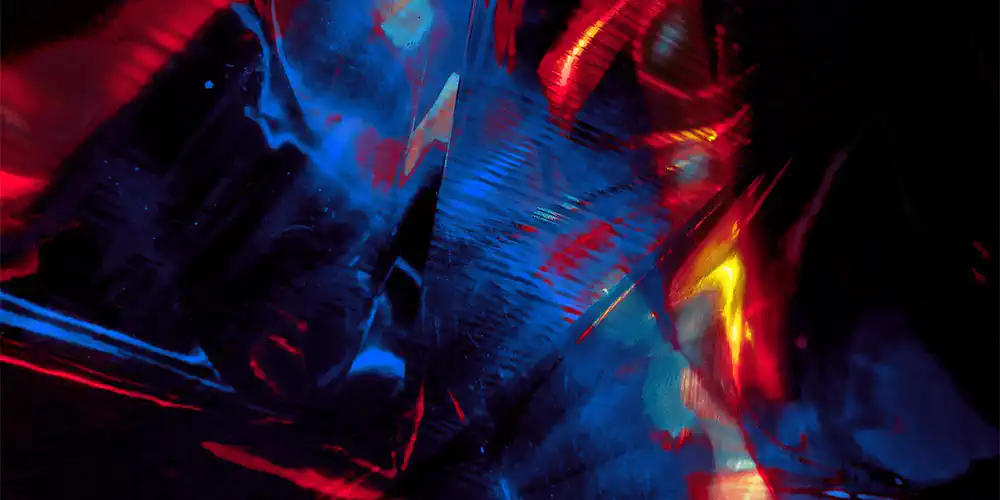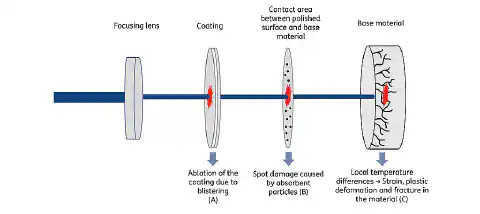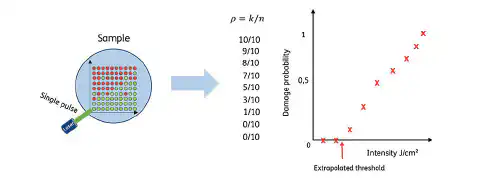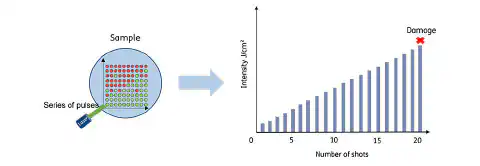
The laser-induced damage threshold in high-power laser optics - Part 2
Morphology and measuring techniques for determining the laser-induced damage threshold
Content
Laser-induced damage (LID) comprises irreversible damage and other changes to material characteristics as a result of melting processes in the material or cracks and holes forming on the surface. Such damage is usually caused in optical components by intense laser radiation. In a previous blog article, we looked at the causes of LID and ways of reducing it.
The phenomenon of LID was described immediately after the introduction of the first lasers in the 1960s. Since then, LID has been one of the most important research topics in the development of high-power laser components. Particular attention is paid to understanding and characterizing LID. Every high-power laser component has a threshold below which a material can withstand intense laser radiation without failing and/or suffering damage. This limit is called the laser-induced damage threshold (LIDT). It’s an essential parameter when selecting and specifying laser optics for laser applications. The LIDT can be determined with the aid of various measuring techniques, some of which are presented and described in this blog article. But let’s start with a brief overview of the types and positions of LID.
Positions and morphology of laser-induced damage
The first part of the series explained the causes of LID, how it can be measured, and how it can be reduced. Damage to high-power laser components mainly results from abrasive processing stages during manufacture, and can arise in the material itself, on the surface of optics, or on optical coatings (see Fig. 1). Damage of this kind can greatly reduce the resilience of optical materials and coatings, and can limit the output power of laser systems. LID can have different morphologies depending on where it occurs. The most common types are listed below:
- Coating ablation: Laser damage resulting from thermally induced laser power causing blistering on coatings (Fig. 1A)
- Spot damage: occurring in dielectric materials with absorbent particles (Fig. 1B)
- Fractures and cracks: High-power laser irradiation leads to local temperature differences, resulting in strain, stress, plastic deformation, and fractures in the substrate material (Fig. 1C)
Fig. 1: Diagram showing different positions of laser-induced damage
The development and extent of damage are largely caused by thermal and electrical mechanisms, which are triggered by ambient conditions (temperature, vacuum, impurities, etc.), specific laser irradiation parameters (wavelength, pulse duration, spatial beam profile, etc.), and production-related factors. The surface and coating of optical substrates are especially susceptible to LID. Optical coating systems in particular tend to take on or even enlarge surface defects in the substrate. It’s therefore important when preparing coatings and surfaces to entirely avoid deposits or contamination. Nevertheless, the effects mentioned can also be intensified by cracks, grooves or other surface imperfections. In addition, surface roughness also affects the LIDT, which is reduced with increasing roughness.
Methods to determine the LIDT
The methods for determining the LIDT are standardized in DIN ISO 11254 and cover most laser applications. The LIDT indicates the damage threshold of a surface, as damage there is more likely than on the carrier substrate. Coatings in particular have the lowest performance in this regard. Therefore, laser optics are tested and characterized using special LIDT tests. For this purpose, either ‘destructive’ single-shot or multi-shot tests are used, in which the optics are irradiated with a defined laser peak intensity and then examined under a microscope to assess any damage. Multiple examination steps are carried out, the laser peak intensity being increased with each step. According to DIN ISO 21254, any detectable change in the sample is considered damage. The aims of this testing are to determine the operating limits and to qualify an optic for usage in a specific system. The LIDT is specified using the laser peak intensity (but note that the pulse duration used during the test must always be documented, too).
There are basically four different test methods:
- 1-on-1 test,
- S-on-1 test,
- R-on-1t est
- Raster scan test
They are explained below.
1-on-1-test
The 1-on-1 test (an ISO-certified LIDT test) is ideal for optimizing manufacturing processes. It’s also regarded as a simple, easy-to-interpret method for determining the LIDT. To carry out the test, the sample surface is subdivided into a matrix or test pattern of spatially separated test sites (cf. Figure 2), which is then irradiated once by a laser with a preselected pulse energy and laser peak intensity. After each pulse, the energy and the condition of the irradiated site are recorded. The sample is examined to identify any damage, and then the probability of damage is calculated. This process is repeated for all other sites while increasing the pulse energy until the damage probability reaches 100%. According to DIN ISO, the threshold equates to the highest amount of laser radiation hitting the optical surface for which the extrapolated (i.e. estimated) probability of damage is zero. The calculation of the LIDT is carried out using suitable extrapolation models and corresponds to an estimate as a function of the pulse energy applied produced.
Fig. 2: Diagram of the 1-on-1 test
S-on-1-test
In contrast to the 1-on-1 test, the S-on-1 test comprises multi-shot testing. Once again, the surface of the sample is divided into a defined matrix with spatially well-separated test sites. However, instead of being irradiated with a laser pulse just once, the test sites are irradiated with a high number of laser shots of the same intensity (usually between 10 and 1,000 shots with a low repeat rate). As in the 1-on-1 test, the intensity is increased with each new test sequence. To determine the LIDT, the number of pulses applied before damage occurs is recorded and used to evaluate the LIDT as a function of the number of pulses. If damage occurs during the test, irradiation is halted to prevent further damage to the sample. The high flexibility of this test method is advantageous because different pulse repetition rates can be applied. In addition, this method provides a significantly more accurate prediction of the actual performance of the optics, which is why the S-on-1 test is the method of choice when it comes to determining the exact LIDT. A practical damage curve is produced showing the energy density values for selected damage probabilities as a function of the number of pulses.
Fig. 3: Diagram of the S-on-1 test
R-on-1-test
Unlike the first two test methods, the R-on-1 test isn’t an ISO-certified test. The main difference is that it’s a ‘ramp test’ in which just one area of the sample is irradiated, the laser intensity being gradually increased until damage occurs (see Fig. 4). This method is very time-consuming because the principle has to be repeated for a large number of test sites depending on the size of the sample and the size of the laser spot; moreover, the same initial intensity has to be used each time. In addition, the damage intensity isn’t determined by extrapolating the damage probability as in the ISO-certified tests. Instead, the highest fluence level at which the damage probability is zero is taken as the LIDT. Furthermore, to ensure the highest possible accuracy, the ramp gradations should be made as small as possible.
Fig. 4: Diagram of the R-on-1 test
Raster scan method
Although the raster scan method isn’t ISO-certified either, it’s increasingly being used due to the growing demands on optical components. It uses much larger spot diameters (1 mm scans 1 cm²), resulting in overlaps and enabling a larger proportion of the surface to be tested. Accordingly, this method is also suitable for large-area optics, since even rare defects can be pinpointed. The performance of a sample is determined by carrying out a multiple pulse raster scanning procedure. Scanning is analogous to the R-on-1 test method in that a point on the sample is irradiated and the fluence steadily increased until damage occurs. The difference is that the LIDT corresponds to the intensity at which ten or more damage events are observed.
Fig. 5: Diagram of the raster scan test
LIDT in high-power laser optics - Summary
The blog article series on the LIDT sheds light on the complex production chain required for optical substrates with high surface qualities and performance properties, which are particularly essential for high-power laser components. However, these manufacturing steps can induce microscopic defects, inhomogeneities and SSD that impair laser optics in terms of their coating quality, mechanical properties and resilience to laser damage. There is clearly great interest in reducing such damage. Especially when used in highly sophisticated laser applications, damage can occur in a wide variety of places and morphologies. Since this damage is partly related to the laser peak intensity, various single-shot and multi-shot tests are used to determine the LIDT when specifying laser optics. The LIDT enables the selection of optical components for specific applications with a view to preventing their rapid wear.





